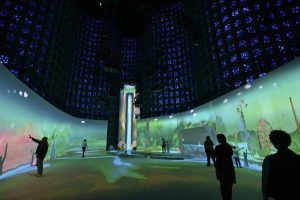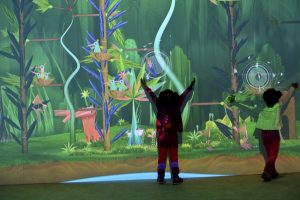


Connected Worlds at the New York Hall of Science is a large-scale immersive and interactive digital ecosystem. Visitors are invited to make gestures, movements and decisions to manipulate the environment around them. As visitors explore and play, they learn to realize that their actions have both short and long-term effects on their surrounding world. Upon visiting, I read that the installation was designed to encourage participants to adopt a more systems thinking approach to sustainability. In this space, users contribute first hand to feedback loops, create casual links and influence the equilibrium of the environment. Connected Worlds is a great example of an effective project that is fun but very educating. The task of educating children on the core concepts of sustainable science is not an easy one. I’ve encountered many exhibits that try to educate children on sustainable science such as the Carnegie Museum of Natural History’s “We are Nature: Living in the Anthropocene.” While these exhibits show a lot of effort to educate visitors on the need to think of local and global effects of their actions, the strongest feelings taken are guilt, rather than real understanding. The creators of Connected Worlds understood that the best way to teach someone something is to have them do it themselves. By providing children the chance to “build” their own environments, they could see the direct effects their actions had on the micro and macro level— no complicated explanation necessary.
![[OLD FALL 2018] 15-104 • Introduction to Computing for Creative Practice](../../../../wp-content/uploads/2020/08/stop-banner.png)